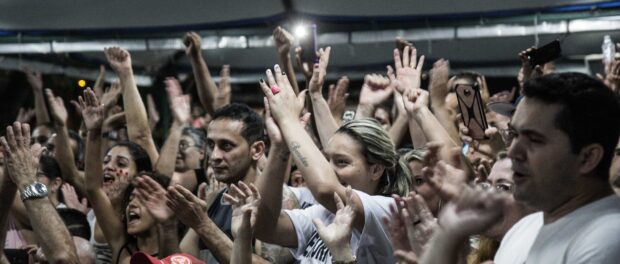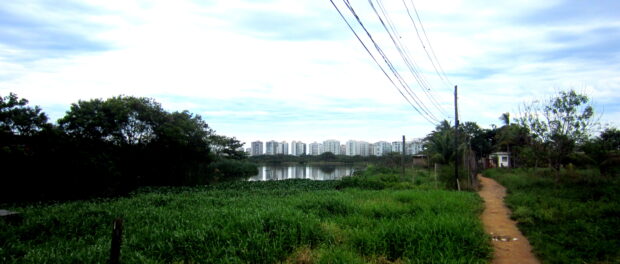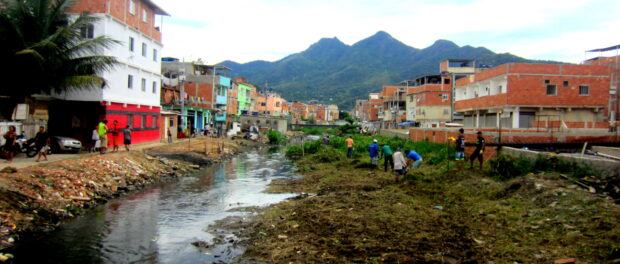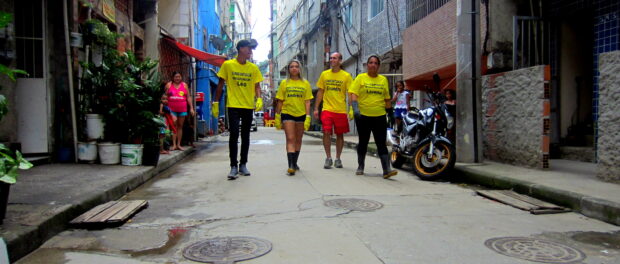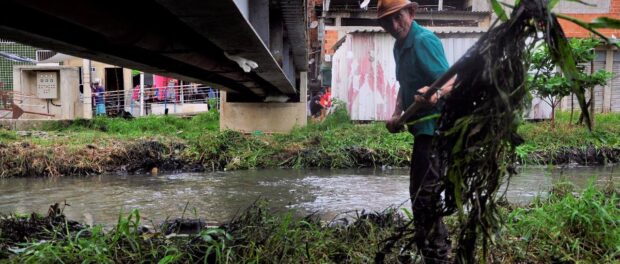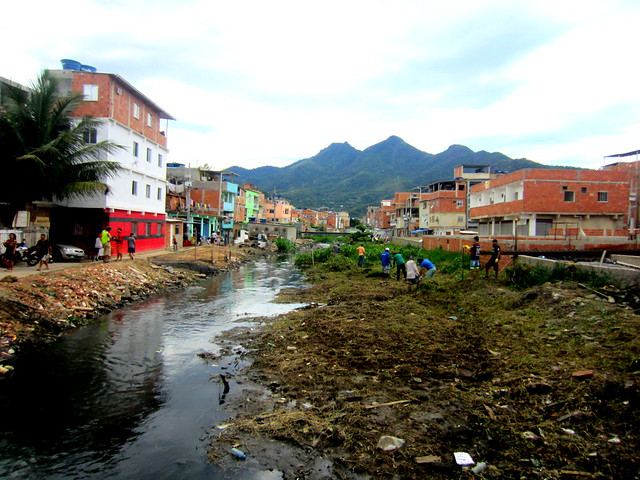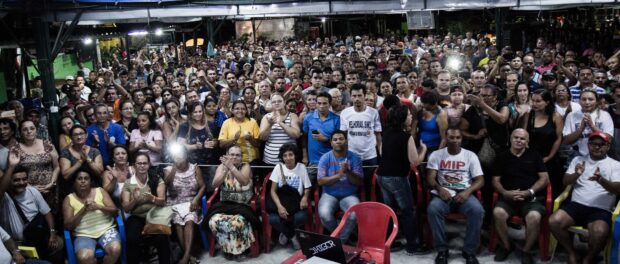
Hundreds of people gathered at the Campo do Via Light in the Rio das Pedras favela, in the West Zone of Rio de Janeiro on Thursday, October 26, to hear an important announcement from the city government regarding the verticalization project proposed in the Strategic Plan of Mayor Marcelo Crivella. After multiple speakers, it was the turn of city councilman and Crivella representative, Paulo Santos Messina, to address the crowd, which had been waiting all evening to hear what he had to say: “Yesterday, a decision about the project was reached… All the resources that were allocated to constructing those buildings, those plazas, will be used to install basic sanitation, to pave roads, to facilitate river water collection, to build channels for the river. Infrastructure for the community as it is now. There will be no evictions.” The crowd erupted in applause and cheers. Messina later went further, stating that there would be no evictions anywhere in Rio under the Crivella administration.
After organizing and mobilizing thousands of residents, the Rio das Pedras commission has won a major victory in the fight against eviction with this announcement. However, that fight is far from over. With the new plan comes new unforeseen problems, and the commission is busy at work keeping tabs on the changes, mobilizing the community, and fighting for fair and humane upgrading plans, not just for Rio das Pedras but for communities across the city.
Rio das Pedras and the Strategic Plan
Rio das Pedras is one of only three favelas explicitly named in Crivella’s Strategic Plan. From the community, residents can see the towering condominium where he lives, and vice versa; as a result, many residents have begun calling his proposal “social cleansing.” The original plan called for the completion of a study on urban requalification in Rio das Pedras by 2018, and Crivella then elaborated a proposal for a process of verticalization. This would have included destroying large swaths of the community, constructing large condominium-like apartment complexes, and then subsequently financing these apartments to the current residents. The proposal did not address deficiencies in the proposed style of public housing, and never outlined how to subsidize the housing for poorer residents or where community members would go during the construction project, which would likely take months, if not years, to complete. The City’s announcement last Thursday was therefore a sigh of relief for many people. However, the City’s new proposal is equally nebulous as the first. While an official document has yet to be released, the commission has received pieces of information from government officials detailing some parts of the project.
Residents are skeptical, and rightfully so. They have been told part of the new proposal includes drilling down until hitting rock and then reinforcing building foundations at a deeper level. While theoretically providing more stability, this process could have disastrous effects for a riverfront community like Rio das Pedras, built in the former wetland region that is now Barra da Tijuca. Community commission member Evandro Teixeira Tavares elaborated:
“The mayor said that he will come with a new project that won’t be verticalization, but upgrading. However, the question is, he said he will enter into narrow alleyways with foundation reconstruction work. How is he going to do foundation reconstruction work in narrow alleyways if there is no way to enter with the machinery? And even if he could, the moment the machinery digs into the ground to do this work, the houses won’t be able to handle it and will collapse. The houses will begin to topple, and obviously, the Civil Defense Department will condemn these houses. It is our understanding that this would be a way to justify, to legitimize, what he really wants to do, which is not upgrading, but verticalization.”
Councilman Messina also announced to the crowd last Thursday that a BRT (Bus Rapid Transit) line would be built through the community with a bus station and three bus stops. The crowd was noticeably angered by his announcement. Commission member Andréia Ferreira reflected: “We have the question of the BRT. We have the perfect example here of Vila Recreio which was a community where they said the BRT was going to pass by, and for this reason they needed to remove the community. However, the BRT was built several meters in front of the community, but it was all removed with this discourse of the BRT.” Teixeira Tavares also noted that the BRT plan would involve widening the main road through Rio das Pedras by 50 meters, something that would almost surely lead to evictions.
In a statement to O Globo about the new proposal, Crivella stated: “We talked with the residents and discussed alternatives. Due to a lack of sewage treatment, that region turned into a kind of latrine in Barra. The proposal is to change this. It is possible that the execution of the new project will still require the resettlement of some families. But this will be negotiated.” However, residents say communication has been almost nonexistent and point out that the community already has several water pumps put in place by the government to pump waste to a treatment facility. However, these pumps were never turned on, so the waste flows directly into the lagoon neighboring the mayor’s condominium. Furthermore, it must be noted that a lack of sewage treatment is a problem across Barra da Tijuca and Rio as a whole, with gated condominiums contributing to the polluted waters too. The fact that Crivella is already contradicting his representative’s claim that there will be no evictions is also worrisome.
Legal Situation
Adriana Britto, one of five lawyers from the Public Defenders Office representing Rio das Pedras spoke to many of the community’s concerns at last Thursday’s meeting. She reminded residents that the majority of the favela was designated an Area of Special Social Interest (AEIS) through Municipal Law 2616 in 1998 and Law 2818 in 1999. Often applied to favelas, the AEIS designation marks and, theoretically, guarantees the land’s particular social value as a housing settlement for predominately low-income families. The lawyer explained that the designation recognizes Rio das Pedras as a working class community and affirms residents’ housing rights in the face of potential real estate speculation. This designation has been an efficient legal tool in fighting forced evictions, although cases like Vila Autódromo show the government can at times break with the very intention of the law by removing a community’s AEIS status.
On the federal level, Brazilian President Michel Temer recently signed Law 13,465/2017, which aims to simplify land regularization but has been criticized for potentially weakening the AEIS designation by exposing favelas to speculative market forces. The Public Defenders Office cites municipal legislation in its defense of Rio das Pedras. Article 429 of the 1990 Organic Law prevents the forced removal of favela homes unless there is direct physical risk to residents.
With this in mind, Britto affirmed that from a legal standpoint in Rio das Pedras “there is no area of risk, so evictions cannot happen.” However, she warned that given that the community has expanded to a population of 140,000 people, according to an estimate provided by the resident’s association, since the AEIS was created in the late nineties, parts of it are now outside the protected area. The public defender said residents must push for the inclusion of the entire community under AEIS. She explained that AEIS means the city government is responsible for implementing infrastructure upgrades and land regularization in the favela.
She said these projects have “to observe the law. In this sense, the law requires two things: it requires that public officials don’t impose [their terms] and it requires that they not try to convince… It is a different process, it is a process of dialogue.” With these words, she portrayed the lack of popular participation in public policy decisions as a fundamental failure of the Crivella administration so far. Rio das Pedras organizers achieved their recent victory by mobilizing residents to demand such a dialogue. Favela coalitions from across Rio have done the same around Mayor Crivella’s Strategic Plan more broadly. The promised upgrades in Rio das Pedras will prove how committed the City is to popular consultation as it moves forward and unveils its specific plans.
Organizing Efforts
The Rio das Pedras commission not only succeeded in thwarting an attempt at illegal evictions by the city government, but it mobilized a large number of the neighborhood’s 140,000 residents to do so. Where there is strength in numbers, however, there is also difficulty. The commission has been tasked with organizing large events and the logistics of getting masses of people to and from them, informing residents from diverse backgrounds across the community about the government’s plan and their resistance efforts, and encouraging involvement in the political process. Many commission members have paused other aspects of their lives completely to devote their time and effort to the movement. When asked how they manage to do all this, Andréia Ferreira laughed and recalled that she is asked this often, but reflected:
“We are able to mobilize because our arguments are really strong. We have the truth on our side. The population of Rio das Pedras already understood this. We just had to make them aware. We are the people, and the movement was completely mobilized, initiated by the people. The people accepted us. They see in us the hope to be heard. When you work with the truth, everything is easier. You don’t need to lie, you don’t need to deceive.”
Her words provide a stark contrast to the city government. While Crivella cites his Christian faith and claims to be “taking care of” the people of Rio, his proposals have threatened to hurt the most vulnerable residents of the city. With contradicting statements about whether there is still any risk of evictions, the mayor seems not to have the truth on his side.
One thing is certain: the commission and residents of Rio das Pedras will continue their fight against eviction and for the betterment of their community. They welcome upgrades, but also want to make clear that it is not the priority. Ferreira stated:
“We will not accept this cowardice. Since the beginning of Crivella’s administration, construction has stopped on one school here. We have a medical clinic that doesn’t have antibiotics, absolutely no resources… People are dying. If he has R$500 million to invest, health and education should be the priority. After this, yes, sanitation, but sanitation without evictions. We know that there are modern, new technologies, so it isn’t necessary to remove anyone. This project is a project of business interests, not community interests. We are watching, we will continue to keep close track.”
Moving Forward
Last Saturday, October 28, the Rio das Pedras commission organized a mutirão, or community-wide clean-up day, in which residents came together to clean up the streets and volunteers spent hours cleaning out the canal that leads to the lake. Municipal trash collection is spotty at best, and this has a negative impact on the sanitation of the community. The commission is taking direct action to better the community and fight against the stigmatizing rhetoric of the city government. “We are doing volunteer work, the residents are mobilizing to do this cleaning. This should be done by the government. This is a community that is completely abandoned, so if the residents don’t do it, no one will. We love our community,” Ferreira stated.
There is something special about Rio das Pedras. Walking into the community, there is a tangible sense of camaraderie and trust. It makes sense. A majority of Rio das Pedras families trace their roots to the northeast of Brazil, migrating to Rio in search of opportunity. Their stories share similar threads, and they are proud of the hard-earned progress they have made over decades. Many Rio das Pedras residents are the construction workers or relatives of the workers who built Barra da Tijuca into the sprawling urban area that it is today, which makes attempts to remove them from the area all the more sinister.
Ferreira’s narration of her community’s history is a powerful argument in defense of its permanence:
“When we speak of Rio das Pedras, we are talking about an example, because [the residents] are people who didn’t have schooling, didn’t have access to any opportunities in life; people who came from the Northeast after suffering from hunger, came to Rio de Janeiro in search of opportunity. It was a beautiful story because this was just a wetland, there wasn’t anything. We arrived here, we fought to be able to live here… We originally had one big shed where everyone lived together. Imagine that coexistence—many families in one place. Then we started making lots. The people worked; the women had to fill in the land, because the men were out working. The families that were just women, we would get a neighbor and help each other out. One big family built Rio das Pedras, initially from wood sheds, with a lot of difficulty. Now after years, you see buildings, amazing houses. Today we feel victorious. Each brick has a story of life.
My grandma arrived here illiterate, worked her whole life in another family’s house and was able to build her own house. It took a lot of work. Now imagine my grandma, an elderly woman who worked her whole life, today without the ability to work like she did before, and the mayor destroys her house and makes her pay. How will she pay the condominium payments with a minimum wage? It’s absurd. I am telling the story of my grandma because it’s the story of everybody here. No one here stole anything. It was all with hard work, really hard work. Years and years of lives worked: a lot of honesty, a lot of sweat, a lot of pain.
And now the mayor comes—cowardice, a lack of respect for our culture, for our history. Today we are proud to say that we have a house. We are not used to condominiums, to luxury, these things. The people here like forró, barbecues, they like hosting their neighbors, everyone together. We were nonexistent to [the government officials for so many years] and when they show up it’s to destroy everything. It’s inadmissible and unacceptable.”

